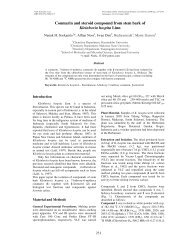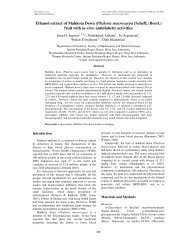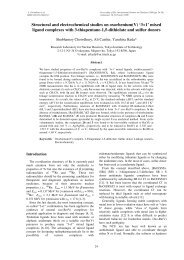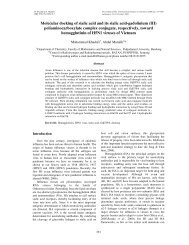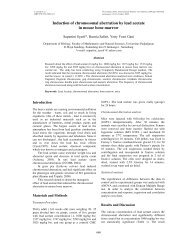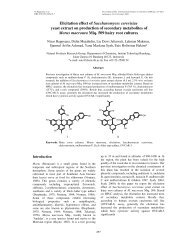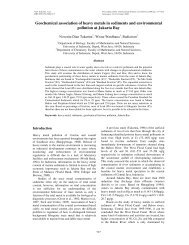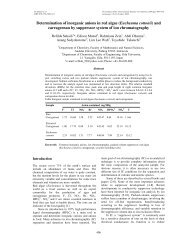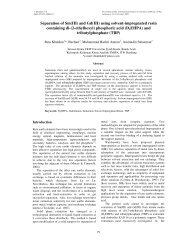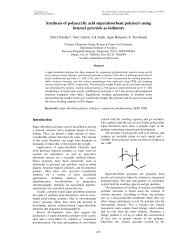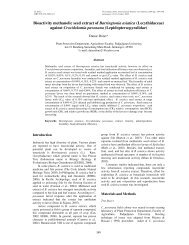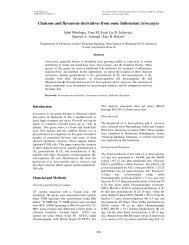Ionic liquids in green chemistry: catalytic reaction of cyclic ...
Ionic liquids in green chemistry: catalytic reaction of cyclic ...
Ionic liquids in green chemistry: catalytic reaction of cyclic ...
You also want an ePaper? Increase the reach of your titles
YUMPU automatically turns print PDFs into web optimized ePapers that Google loves.
L.W. Wijayanti et al. Proceed<strong>in</strong>g <strong>of</strong> The International Sem<strong>in</strong>ar on Chemistry 2008 (pp. 356-362)Jat<strong>in</strong>angor, 30-31 October 2008Table 5 List <strong>of</strong> variation <strong>of</strong> Henry’s law coefficient with temperature <strong>of</strong> 1-3-dialkylimidazolium dialkylphosphate ionic <strong>liquids</strong>Compound T/K H 21 /MPa Error a313.15 10.64 0.12[MMIM][Me 2 PO 4 ] 323.15 12.72 0.03333.15 15.22 0.15313.15 6.99 0.03[EMIM][Et 2 PO 4 ] 323.15 8.12 0.04333.15 9.66 0.02313.15 4.98 0.02[BMIM][Bu 2 PO 4 ] 323.15 5.76 0.02333.15 6.85 0.03a Standard errors <strong>of</strong> the isotherm slopes10 3 x240353025201510500 50 100 150 200p/kPaFigure 4 Solubility CO 2 <strong>in</strong> [BMIM][Bu 2 PO 4 ] at (●)313.15 K, (■) 333.15 K, and (▲) 323.15 Kat atmospheric pressureIn our experiments, the Henry’s law coefficient at aspecified temperature was estimated from the slope <strong>of</strong>a l<strong>in</strong>ear fit <strong>of</strong> the CO 2 solubility <strong>in</strong> mole fractionversus fugacity. The Henry’s law coefficients atvarious temperatures and the standard error <strong>of</strong> theisotherm slopes are given <strong>in</strong> the Table 5. As can beseen, all <strong>of</strong> the Henry’s law.ConclusionsA series <strong>of</strong> ionic liquid-based imidazolium z<strong>in</strong>ctetrahalide and (1-R-3-methylimidazolium) 2 ZnX 2 Y 2 ,were prepared by react<strong>in</strong>g ZnX 2 with (1-R-3-methylimidazolium)Y.The s<strong>in</strong>gle crystal X-ray structural analysis andelemental analysis <strong>of</strong> (1,3-dimethylimidazolium) 2ZnBr 2 Cl 2 revealed that two imidazolium cations werepaired with a dibromodichloro z<strong>in</strong>cate dianion.The <strong>catalytic</strong> activities <strong>of</strong> imidazolium z<strong>in</strong>ctetrahalide were evaluated for the coupl<strong>in</strong>g <strong>reaction</strong>s<strong>of</strong> epoxides and CO 2 , and the effects <strong>of</strong> halide ions,imidazolium cations, temperature and pressure were<strong>in</strong>vestigated. The <strong>catalytic</strong> activity <strong>of</strong> (1-R-3methylimidazolium) 2 ZnX 2 Y 2 was found to <strong>in</strong>creasewith <strong>in</strong>creas<strong>in</strong>g nucleophilicity <strong>of</strong> halide ion. But, thesubstitution on the imidazolium cation showed anegligible effect on the <strong>catalytic</strong> activity. Theformation <strong>of</strong> <strong>cyclic</strong> carbonate was strongly dependenton the temperature but <strong>in</strong>dependent <strong>of</strong> the pressure <strong>of</strong>CO 2 . The reactivity <strong>of</strong> alkylene oxide was greatlyaffected by the substituent at the carbon atom <strong>of</strong> theepoxide. Ethylene oxide and alkylene oxides with lessbulkier substituents produced correspond<strong>in</strong>g alkyleneoxides <strong>in</strong> high yields. However, alkylene oxides withbulky or electron-withdraw<strong>in</strong>g substituents aroundepoxide groups gave much lower yields <strong>of</strong> alkylenecarbonates.The CO 2 solubility <strong>in</strong>creases l<strong>in</strong>early with pressure<strong>in</strong> all <strong>of</strong> the dialkylimidazolium dialkylphosphateionic <strong>liquids</strong> and decreases as temperature <strong>in</strong>creases.It means that dialkylimidazolium dialkylphosphatehave capability to capture CO 2 through physical<strong>in</strong>teraction.AcknowledgementsThis work was supported by the M<strong>in</strong>istry <strong>of</strong>Environment <strong>in</strong> Korea and presented by Ms. LuciaWiwid Wijayanti, M.SiReferencesA. Behr, Carbon Dioxide Activation by MetalComplexes, VCH, New York, 1988.D.J. Darensbourg, M.W. Holtcamp, Coord. Chem.Rev. (1996) 153.T. Kim, S. Vijayalakshmi, S. Son, S. Ryu, J. Kim, J.Ind. Eng. Chem. 9 (2003) 481–487.B. Sea, Y. Park, K. Lee, J. Ind. Eng. Chem. 8 (2002)290–296.M. Aresta, E. Quaranta, ChemTech. Mar. (1997) 32–40.A.G. Shaikh, Chem. Rev. 96 (1996) 951–976.D. Lee, J. Hur, B. Kim, S. Park, D. Park, J. Ind. Eng.Chem. 9 (2003) 513–517.J.J. Lagowski, The Chemistry <strong>of</strong> NonaqueousSolvents, Academic Press, New York, 1976.M. Inaba, Z. Siroma, A. Funabiki, M. Asano,Langmuir 12 (1996) 1535–1540.361



